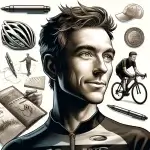
Estimated reading time: 9 minutes
Table of contents
- Introduction
- The Demonization of EPO: A Historical Perspective on Anti-Doping
- Which Scholars Deconstructed Other Instances of Anti-Doping Propaganda?
- What are the Different Types of Anti-Doping Testimonies Used as Propaganda?
- Searching for Evidence
- What a Literature Review of Relevant Evidence Says About Connection Between EPO and Cyclist Deaths
- What Does Bernat Lopez Conclude About EPO and Cyclist Deaths in the Late 1980s/1990s?
Introduction
Fact or Fiction: Did EPO cause the high number of sudden cardiac deaths among professional cyclists in Belgium/Holland during the late 1980s and early 1990s?
In sports history, few controversies have ignited as much debate as the alleged link between erythropoietin (EPO) and sudden cyclist deaths during the late 1980s and early 1990s. As professional cycling soared in popularity, so did claims that ‘EPO doping’ was not only rampant but also deadly.
But is the use of EPO as dangerous as some scientists would have athletes believe? Many suggest that the equation of EPO doping with sudden deaths is nothing more than a myth. For example, Bernat Lopez has led an investigation, seeking to unravel the “demonization of EPO”. Lopez, a renowned researcher from Spain, has made some waves in the world of sports analysis, penetrating mainstream debate, causing questions to arise regarding these claims and the evidence supporting them
How Does Anti-Doping Propaganda Work?
The crux of the controversy lies in the assertion that doping with EPO was responsible for a significant number of sudden deaths among professional cyclists in Belgium and Holland. These fatalities reported between 1987 and 1990 have been cited as evidence of the lethal consequences of wider doping practices within the sport.
Is there truly a causal link between EPO blood doping and cyclist deaths, or have the agendas of anti-doping campaigners distorted this narrative?

The Demonization of EPO: A Historical Perspective on Anti-Doping
EPO has become something of a central figure in the war against doping in sports. As a potent tool for enhancing endurance and performance, EPO quickly became a focal point of anti-doping campaigns, portrayed as both a shortcut to victory and a deadly threat to athletes.
Scaremongering tactics were central to the demonization of doping, with what some described as the propagation of what can be termed ‘flagship myths.’ This is a phenomenon where facts and figures are ignored or fabricated for the sake of the ‘greater good’ – essentially painting all PEDs as ‘Weapons of Mass Destruction.’
Portrayal of EPO as a Deadly Substance
The portrayal of EPO as a deadly substance can be traced back to the late 1980s and early 1990s when allegations surfaced linking its use to a spate of sudden deaths among professional cyclists in Belgium and Holland. This narrative was perpetuated by media sensationalism and fervent anti-doping advocates––such as Paul Kimmage, who testified to “athletes dropping dead” in his autobiography––painted EPO as a ticking time bomb, capable of triggering fatal heart strokes and embolisms in unsuspecting athletes.
Scientists like Robin Parisotto and Dr. David Gerrard publicly made statements against EPO alongside Kimmage, referencing heart attacks, strokes, and sudden deaths. The fact that all of these individuals have operated on anti-doping organizations made the claims appear more reliable, while some argue that they served to fuel a more hardline approach against doping.
Anecdotes as Fact
Upon closer scrutiny, it becomes evident that the demonization of EPO may have been fueled more by rhetoric and anecdotes than scientific evidence. While some EPO adverse effects are undeniable, they are related to misuse of the drugs and the extent to which it can be implicated in athlete deaths remains a matter of contention.

Which Scholars Deconstructed Other Instances of Anti-Doping Propaganda?
Challenging the Status Quo
Scholars such as Verner Møller, Paul Dimeo, and Bryan Denham have played pivotal roles in shedding light on anti-doping campaigns and the underlying motivations driving them, with Møller labeling the anti-doping campaign ‘a crusade that must not fail’. Their research offers critical perspectives on the construction of anti-doping narratives, highlighting the influence of media sensationalism, moral panic, and political agendas in shaping public discourse on drug use in sports.
Verner Møller’s Findings
Møller’s work, including his examination of Knud Enemark Jensen‘s death during the 1960 Rome Olympics, provides valuable context for understanding the historical roots of anti-doping efforts and the evolution of PED myths over time. In his research, he challenged the presumption that Jensen was killed by amphetamine use––something that fueled anti-doping campaigns for years.
Paul Dimeo’s Findings
Similarly, Dimeo’s completed analysis of a claim about Arthur Linton’s alleged death from doping in cycling in the late 1800s points out that there’s no empirical evidence to back up the claims. This informs his belief that these historical deaths cannot be used to back up EPO doping campaigns in the present day.
Bryan Denham’s Findings
Meanwhile, Denham’s exploration of the media’s role in framing narratives surrounding anabolic steroid use, especially in the case of pro player Lyle Alzado’s death, underscores the power of rhetoric in shaping public perception and policy responses. Denham highlights the biases and contradictions inherent in anti-doping discourse, deconstructing the language used to vilify PEDs and their users, despite a lack of ‘cause-effect’.
What are the Different Types of Anti-Doping Testimonies Used as Propaganda?
In anti-doping advocacy, testimonies from key figures such as Paul Kimmage, Robin Parisotto, and David Gerrard often shape public opinion and policy decisions. However, we must subject these testimonies to critical scrutiny, examining the rhetoric used to vilify EPO and its alleged role in cyclist deaths.
Criticizing Paul Kimmage: Journalistic Propaganda
Kimmage, a former professional cyclist turned journalist, has been a vocal critic of doping in sports, drawing attention to ethical and moral dilemmas athletes face. While his firsthand experiences lend credibility to his testimony, it is crucial to consider the potential biases and agendas that may influence his narrative, while also noting a general lack of evidence.
Criticizing Robin Parisotto: Populist Scientific Propaganda
Similarly, Parisotto, a prominent figure in the anti-doping and populist sciences, has provided expert testimony on the dangers of EPO. While his expertise lends authority to his claims, a lack of consistency in his reporting shows that his claims can’t be taken as gospel.
Criticizing David Gerrard: Academic Scientific Propaganda
Gerrard, an academic with expertise in sports medicine, once cited a source regarding EPO deaths, despite its lack of precision and clarity. This aligns with many of his academic texts and journalistic reports that also lack precision, with varying figures and timelines for the deaths.
In dissecting these testimonies, it becomes evident that the rhetoric used to vilify EPO often relies on emotive language, anecdotal evidence, and appeals to moral outrage. By subjecting these claims to critical scrutiny, we can strive toward a more nuanced and evidence-based approach to addressing the complex issue of drug use in sports.

Searching for Evidence
We can gauge the strength of the evidence supporting the alleged link between EPO doping and cyclist fatalities by evaluating the sources cited in discussions of EPO doping deaths among cyclists for their reliability, credibility, and bias.
In Lopez’s study, only two out of 61 reviewed texts provide solid original sources for the figures regarding cyclist deaths, with many of the reports coming from newspapers rather than academic studies. This lack of substantiation raises doubts about the claim of a sudden spate of deaths.
By examining trends over time, such as in the LexisNexis database and across different sports, researchers can identify patterns that shed light on the relationship between EPO use and fatalities among cyclists. By applying a systematic literature review of the 1101 sudden cardiac deaths in athletes under 35 between 1980 and 2006, only a small number were cyclists, with 90% of the total figures connected to underlying heart disease.
This data is also illuminating as it shows most of these sudden deaths occurred within soccer, basketball, running – sports not traditionally associated with EPO use. Using this data, researchers can confidently conclude EPO is unlikely cause of sudden death.
What a Literature Review of Relevant Evidence Says About Connection Between EPO and Cyclist Deaths
It’s important to consider whether these studies on EPO doping deaths are based on rigorous scientific inquiry or rely on anecdotal reports and theoretical speculation. For example, between 1980 and 2006, only 2% of sudden deaths in young US athletes were attributed to illicit drug use. Despite claims of EPO circulating in Europe since 1987, many of the recorded deaths involved retired cyclists or occurred during the off-season when EPO use would be unlikely, casting doubt on the alleged link.
Randy E. Eichner, a hematologist at the University of Oklahoma Health Sciences Center, is a prominent figure in discussions about EPO. His metaphor of “blood becomes mud” has been widely circulated, even by reputable magazines like Der Spiegel. Eichner and other doctors, such as Ed Berg and Joseph Eschbach maintained dismissive attitudes toward dissenting opinions, despite empirical evidence to support their claims, suggesting corruption.
It’s also worth noting other notable doctors of the time have completed reference with no clear findings on EPO related to the deaths, including: Berglund and Ekblom, Besarab, Wagner et al, Boraita, Maron, Subirana, and Denker. By applying a rigorous and transparent approach to evaluating the medical literature, researchers can ascertain claims of cyclist deaths attributed to EPO use are often sensational and lacking solid evidence.
What Does Bernat Lopez Conclude About EPO and Cyclist Deaths in the Late 1980s/1990s?
After a thorough examination of Lopez’s text, it becomes clear that the narrative of EPO as a deadly substance lacks empirical support, with two main focuses of anti-doping campaigns highlighted:
- The “suspicious” series of cyclist deaths in two different countries, which revealed significant gaps in the evidence presented by anti-doping advocates.
- An intention to isolate EPO as the sole subject of the discussion.
Scientific literature and anecdotal evidence fail to substantiate that EPO caused the deaths of Dutch and Belgian cyclists during the late 1980s and early 1990s.
The scientific literature in this research does not support the claims of fatal heart strokes or embolisms from EPO, as many of the athletes had pre-existing conditions. Even anecdotal evidence rules out or downplays the possibility of EPO having caused sudden death among the Dutch and Belgian cyclists who passed in the late 1980s.
The perpetuation of unsubstantiated claims and sensationalist narratives undermines the credibility of anti-doping efforts and the wider regulatory frameworks governing sports. Lopez’s research indicates quite the opposite of what appeared to be a common opinion for some time.
While there was a lack of evidence in this specific crusade, that’s not to say that EPO is entirely safe to use willy-nilly. It’s clear that there are gaps in the scientific literature on this exact case, but that doesn’t mean athletes shouldn’t have proper access to the right resources when they need them. In our next articles, we’ll be taking a closer look at the positive effects EPO can have on cycling performance, along with describing a detailed protocol for testing EPO on athletes.
Reference
López, B. (2011). The Invention of a ‘Drug of Mass Destruction’: Deconstructing the EPO Myth. Sport in History, 31(1), 84–109. https://doi.org/10.1080/17460263.2011.555208
About the author
Wheeler Swift is a seasoned sports writer and cycling enthusiast with over a decade of experience covering competitive cycling and performance-enhancing substances (PEDs). With a keen eye for detail and a passion for uncovering the truth, Wheeler combines his background in sports science with his love for cycling and a deep interest in the world of PEDs to provide in-depth analysis and insightful commentary. When he's not writing, you can find Wheeler on his bike, exploring new trails and pushing his own limits.

No replies yet
Loading new replies...
Join the full discussion at the MESO-Rx →